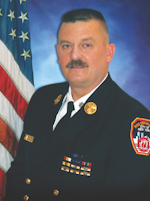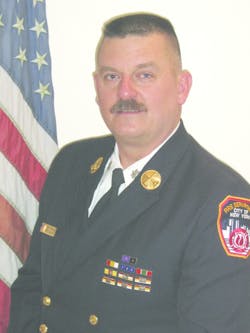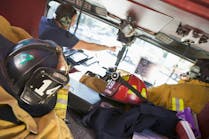Many firefighters use the term “Stay safe!” with fellow firefighters. It is a common phrase that many of us use casually, and sometimes I think we say it without actually knowing what it means. What do you think “Stay safe!” means? Let’s talk about the WORD “safe” and the condition of being safe.
When we say the word “safe,” we are all talking about the same thing. We are talking about firefighters who are able to fight fires in burning buildings, perform extrications on busy highways and complete all sorts of other dangerous and risky assignments without being injured or killed. It’s a simple, yet serious concept.
The problem with the phrase “Stay safe!” is that it is a wish. I like to think of “safety” as a destination. It’s where we want to be when the job is complete and when the shift is over. You can’t just say “Stay safe!” and it happens. Make no mistake; none of us can stay safe by saying it or wishing it. There are activities and actions that can keep you safe, and without them staying safe will be an unattainable goal.
Importance of training
I believe the most important activity that promotes safety is training. Nothing has a greater effect on the safety of individual firefighters or teams of firefighters than regular and effective training. So what is regular and effective training? Regular means all the time. For a career firefighter, that means every time you are on duty. Not every other shift, every shift. A volunteer firefighter should be training at least once a week. When I was a young volunteer, I couldn’t wait for the weekly training night. Train and be safe.
Standard operating procedures (SOPs) are another element of a safe operation. It is surprising to see how many fire departments do not have a single written procedure for their companies to follow or be guided by. It is important to take the time to develop and follow accepted and effective procedures. Following SOPs keeps firefighters within bounds and prevents them from wandering and randomly selecting tactics and tools for the situation they are facing. If each company, each officer and each chief handles the same situation differently, you can see how this can lead to confusion and danger. Following procedures provides a path for us to follow and therefore operate more safely.
Having and properly wearing approved personal protective equipment (PPE) is another element of a safe operation. The gear we wear – helmets, gloves, boots, bunker pants and coats, hoods and self-contained breathing apparatus (SCBA) – are designed and produced to protect our bodies from the extreme conditions we are exposed to while fighting fires, performing extrications, operating at confined space operations and elsewhere. We are all exposed to hazardous and dangerous conditions at just about every call. High temperatures, toxins, sharp edges and impacts are just some of the dangers.
Many firefighter injuries and fatalities can be traced to improperly worn or absent PPE. Something as simple as wearing eye protection while sharpening tools or cleaning equipment can make the difference between a career-ending injury and a simple mishap on a workbench. Properly wearing PPE means every zipper, snap and buckle is securely fastened. It is properly donning the SCBA facepiece. It is wearing gloves all the time. Using eye protection during every extrication. Fastening the SCBA waist strap every time it is worn. Entering every building for an investigation wearing SCBA. Properly worn PPE makes every run and every job safer.
Annual firefighter fatality statistics show that many firefighter line-of-duty deaths are related to or caused by heart attacks and other stress-related physical conditions. In some years, as many as half of all line-of-duty deaths are listed as cardiac related.
There is an obvious problem here – physical fitness, or the lack thereof, in the American fire service is our dirty little secret. How can we be even talking about rapid intervention, the “two-in/two-out” rule or positive-pressure ventilation (PPV) when half of the firefighters who die each year may not have been fit to perform the work they were required to do. Being physically fit is a major element of staying safe. We can’t expect to improve the level of safety on the fireground if we let “fragile” personnel engage in the most physically demanding work inAmerica.
I hope my view of staying and being “safe” has given you an important new perspective on this evolving issue. Hey, “Stay safe”!
Chief Salka takes a candid look at news and events impacting the fire service in his blog “The Fire Scene” at http://www.firehouse.com/blogs/the-fire-scene.
JOHN J. SALKA Jr., a Firehouse® contributing editor, recently retired as a battalion chief with FDNY, serving as commander of the 18th battalion in theBronx. Salka has instructed at several FDNY training programs, including the department’s Probationary Firefighters School, Captains Management Program and Battalion Chiefs Command Course. He conducts training programs at national and local conferences and has been recognized for his firefighter survival course “Get Out Alive.” Salka co-authored the FDNY Engine Company Operations manual and wrote the book First In, Last Out – Leadership Lessons From the New York Fire Department. He also operates Fire Command Training (www.firecommandtraining.com), a New York-based fire service training and consulting firm.

John J. Salka Jr. | Battalion Chief
JOHN J. SALKA JR., who is a Firehouse contributing editor, retired as a battalion chief with FDNY, serving as commander of the 18th battalion in the Bronx. Salka has instructed at several FDNY training programs, including the department’s Probationary Firefighters School, Captains Management Program and Battalion Chiefs Command Course. He conducts training programs at national and local conferences and has been recognized for his firefighter survival course, “Get Out Alive.” Salka co-authored the FDNY Engine Company Operations manual and wrote the book "First In, Last Out–Leadership Lessons From the New York Fire Department." He also operates Fire Command Training, which is a New York-based fire service training and consulting firm.






